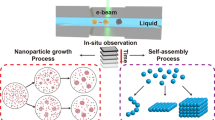Abstract
Three-dimensional (3D) ordered macroporous indium tin oxide (ITO) is prepared using a polymer colloidal crystal template that is formed by self-assembly of the monodisperse poly(methyl methacrylate) (PMMA) microspheres. The morphologies and BET surface area of the macroporous material is examined by scanning electron microscope, transmission electron microscopy and N2 adsorption/desorption. Results indicate that the macroporous material has highly ordered arrays of the uniform pores replicated from the PMMA colloidal crystal template when the polymer colloidal crystal template is removed by calcinations at 500°C. The pore diameter (about 450 nm) of macroporous ITO slightly shrank to the PMMA microspheres. The BET surface area and pore volume of the macroporous material are 389 m2·g−1 and 0.36 cm3·g−1, respectively. Moreover, the macroporous ITO, containing 5 mol% Sn and after annealing under vacuum, shows the minimum resistivity of ρ = 8.2×10−3Θ·cm. The conductive mechanism of macroporous ITO is discussed, and it is believed that the oxygen vacancies are the major factor for excellent electrical properties.
Similar content being viewed by others
References
Raman N K, Anderson M T, Brinker C J. Template-based approaches to the preparation of amorphous, nanoporous silics. Chem Mater, 1998, 8: 1682–1701
Stein A. Sphere templating methods for periodie porous solids. Macroporous Mesoporous, 2001, 44: 227–239
Blaaderen A V. Opals in a new light. Science, 1998, 282: 887–888
Xia Y, Gates B, Li Z Y. Self-assembly approaches to three-dimensional photonic crystals. Adv Mater, 2001, 13: 409–413
Velev O D, Jede T A, Lobo R F, et al. Porous silica via colloidal crystallization. Nature, 1997, 389: 447–448
Jiang P, Hwang K S, Millteman D M, et al. Template-directed preparation of macroporos polymers with oriented and crystalline of voids. J Am Chem Soc., 1999, 121(50): 11630–11637
Park S H, Xia Y. Macroporous membranes with highly ordered and three-dimensionally interconnected spherical pores. Adv Mater, 1998, 10(13): 1045–1048
Holland B T, Blanford C F, Stein A. Synthesis of macroporous minerals with highly ordered three-dimensional arrays of spheroidal voids. Science, 1998, 281: 538–540
Velev O D, Lenhoff A M. Colloidal crystals as templates for porous materials. Curr Opin Colloid Interf Sci, 2002, 5: 56–63
Chopra K L, Major S, Pandya D K. Transparent conductors—a status review. Thin Solid Films, 1983, 102: 1–12
Suntola T. Atomic layer epitaxy. Thin Solid Films, 1992, 216: 84–89
Shewchun J. The operation of the semiconductor-insulator-semiconductor solar cell: Experiment. J App Phys, 1979, 50: 2832–2834
Long Y, Xu J, Zhang X, et al. Synthesis of ordered macroporous silica using poly(metyl methacrylate) colloid crystal as templates. J Natl Univ Def Tech (in Chinese), 2003, 24(4): 20–23
Rong J, Yang Z, Qi K, et al. Synthesis of 3D ordered porous polystyrene using silica template. Chin Sci Bull, 2001, 46(4): 306–308
Cong H, Cao W. Two array manners and packing modes in colloidal crystals. Chem J Chin Univ (in Chinese), 2003, 24(8): 1489–1491
Xu R, Pang W, Yu J. Chemistry-Zeolites and Porous Materials (in Chinese). Beijing: Science Press, 2004. 145–148
Fan J C C. Effect of O2 pressure during deposition on properties of Rf-sputtered Sn-doped In2O3 films. App Phys Lett, 1977, 31: 773–775
Fan Z. The theoretical upper limitation of carrier concentration for ITO. Adv Display (in Chinese), 2000, 3: 18–22
Zhang S, Huang B, Fang S. Semiconducting mechanism, applications and fabrication of ITO films. Mater Rev (in Chinese), 1997, 11(4): 11–14
Chen M, Bai X, Huang R, et al. XPS and AES studies of ITO thin films. Chin J Mater Res, 2000, 14(2): 173–178
Ota R, Seki S, Ogawa M, et al. Fabrication of indium-tin-oxide film by dip coating process using ethanol solution of chlorides and surfactants. Thin Solid Films, 2002, 411: 42–45
Author information
Authors and Affiliations
Corresponding author
Rights and permissions
About this article
Cite this article
Zhang, X., Man, Y., Wang, J. et al. Synthesis of 3D ordered macroporous indium tin oxide using polymer colloidal crystal template. SCI CHINA SER E 49, 537–546 (2006). https://doi.org/10.1007/s11431-006-2009-y
Received:
Accepted:
Issue Date:
DOI: https://doi.org/10.1007/s11431-006-2009-y



